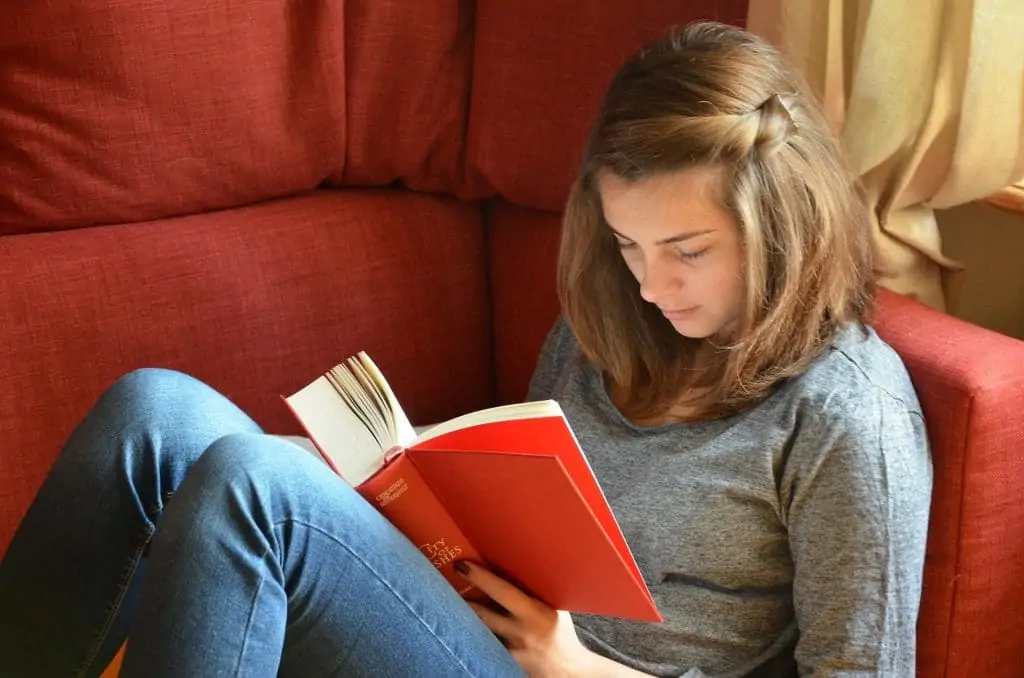Are you struggling with how to effectively get the most out of your reading your textbook? Are you looking for strategies to aid you in simultaneously reading and taking notes? If you have answered yes to either one of these questions, then you have come to the right place.
This guide aims to provide you with effective reading techniques and tips for how to study from a textbook. Imagine studying a book all night only to find that you have not retained anything. Imagine how much time you have wasted in your past by incorrectly reading your textbooks. We want to help make sure you never waste your time again.
We will provide you with the ultimate guide for studying and learning from your textbook. This includes tips on how to study from your book, exploring the SQ4R method, and providing you with practical strategies for college and high school reading.
These tips and strategies are at the tip of your fingertips. All you must do is keep reading to uncover them.
 Why Reading Your Textbook is Important for Acing Your Classes
Why Reading Your Textbook is Important for Acing Your Classes
Your textbooks contain information that your notes do not.
Learning how to read and take notes from your textbook is an essential part of conquering your courses. Many teachers will provide you with handouts of slides, lecture notes, and supplemental material. However, it is safe to say that your instructor will never hand you everything that you need to know for exams, quizzes, or even future references. All this material should be used in conjunction with the notes you receive from your instructor. If there were no work for you to do on your own, you would not be in a class.
You will find an abundance of sample questions and worked out problems.
Another advantage of reading your textbook is having an abundance of examples and problems at your fingertips. Your book should never be your added resource, but instead your main one. Textbooks are beneficial not just for learning new material, but if you are confused as well. When going over new concepts, some information may be hard to grasp on the first try. Your textbook generally gives you examples, review material, and even worked out samples.
This notion is especially true for math and science courses. When going over how to do calculations and other work that may not be as straightforward, it’s essential to review a variety of question types as well as solutions. Your textbook also contains answers for a subset of its problems. These answers can aid you in seeing what you are doing wrong.
Do you know how reliable Google is?
What happens when the wrong information is placed online? Though it can be altered, what about the individuals who have already taken the incorrect information as facts? Though we live in an era where it is acceptable to Google everything, I’m sure you have found by now that the internet can, unfortunately, be wrong sometimes.
Though textbooks may have typos or slight errors at times, most of them have been vetted for truth and checked to ensure credibility. Authors are responsible for the information they give. As a seasoned professional in an industry, for them, maintaining their reputation is just as crucial as writing the textbook. Textbooks are also tangible, and the information printed in them is permanent. If an author wants to make a change to a new edition is needed and broadcast to users.
 How to Read Your Textbook Without Getting Bored
How to Read Your Textbook Without Getting Bored
One reason that many people can never get through their assigned reading is simply that it’s boring. However, reading your textbook doesn’t have to be a snooze. If you’re wondering how to read a textbook without getting bored, this section will help you combat that.
Find a suitable place to read.
Changing your atmosphere is a great way to combat boredom. Though you are not consistently interacting with your surroundings when you study, certain areas may or may not be conducive to your reading success. For example, you should never study on a bed or any place that can be too comfortable. One minute you can be reading about anatomy, and the next minute, you are counting sheep. Bookstores and coffee shops are a great place to read because not only do they provide a vibrant environment to study and unlimited refreshments, they are also reasonably quiet. Libraries are no longer your only option for getting work done.
Read in short spurts or intervals.
Reading can be difficult, especially if you are reading about a subject that you do not particularly care for. Instead of attempting to sit down and read a whole chapter straight through, read in short spurts. This reading can be done by heading or by section. If the sections are still too long, you can even read, as short as a paragraph at a time.
You can also group your reading by time. For example, reading in 30-minute chunks and taking five-minute breaks allows you to engage with the book in a manner that is less stressful or rushed. Reading in intervals may require planning when looking to read large chunks of material.
Eliminate any outside distractions.
Reading while your roommate is attempting to have a party is a terrible idea. The first thing you should do when you sit down to study is to eliminate any outside distractions. This includes social media, loud music, and sometimes even friends. This way, you can focus on your studying, and you will not feel like you’re missing something. Reading, while being distracted, can also prevent you from enjoying the material you are reading.
Ask questions.
One helpful way to ensure that you are getting the most out of the reading is to turn your chapter headings and section titles into questions. This strategy allows you to not only read the section but read with intention. Your notes should serve as a means for answering the question and summarizing the section.
Put the text in your own words.
Let’s face it; you can probably remember song lyrics better than anything you’ve ever read in a textbook. No, there is nothing wrong with you. Your brain, however, may have a harder time processing information written in “textbook jargon” rather than plain English. Therefore, work on putting information in a form you can understand. Circle words from your text that you don’t understand or information that is important and paraphrase it in your notes. Therefore, when you are reviewing your notes, it’s easier to retain.
Effective Reading Strategies for High School Textbook Readings
Use the resources available to you.
As a high school student, you will not understand everything. You will ultimately run into words or information you are unfamiliar with. However, you should not simply skip this information. Skipping this information is only doing yourself a disservice.
Instead, grab a dictionary or thesaurus to ensure you fully understand what the material is saying. Use the resources around you. If there is something you are unsure about, research it before moving forward. This term or phrase could turn out to be the thing that makes or breaks your grade in a class.
Contrary to popular belief, your teacher is also a resource. Reading in high school is very different from reading in college. Whenever you are confused or feel as if you are not interpreting the text correctly, don’t be afraid to ask for help. The skills you learn in high school will better prepare you for more independent reading in college.
Use sticky notes or book tabs when reading.
One significant difference between high school and college is the ability to write in or own your textbook. For this reason, book tabs are your friend. Book tabs allow you to mark and annotate information directly on the text without writing on the page. They also allow data to be easily translated into your notes.
Identify a purpose for your reading.
If your instructor has not provided one, ask questions that will help you decipher the intent of the reading. This is particularly helpful for readings being done in a set content area. Having a purpose helps you to read with intention and not give up before you are finished.
 Effective Reading Strategies for College Textbook Readings
Effective Reading Strategies for College Textbook Readings
Don’t forget to pre-read.
Pre-reading the chapter helps you to understand what the section will be about. It allows you to understand what is coming next and understand what you’re reading. You should read any headings, titles, keywords, or boxed equations. You should begin by counting the pages for the chapter, so you understand what you have left. You are prereading with the purpose of recognition in mind. The more your brain can understand, the better. Prereading puts you in the mindset for reading. It also helps you to create a roadmap for your reading.
Read the introductions and summaries.
Though we often want to skip introductions and summaries, don’t do it. They are there for a reason and can ultimately be a help to you. Though the end of chapter summary or other information within the chapter may not entirely make sense before reading, they are preparing your brain for what is to come. Once you have completed your reading, go back and reread the summaries, it should make more sense now that you have completed the chapter. It should also further reinforce the information you read.
Read with your pen in hand.
When reading, we may tend to over highlight items we may think are important, but in reality, they aren’t. Instead, read with your pen in hand. If you aren’t disciplined enough, don’t even use your highlighter. Reading with your pen allows you to take notes as you read without having to go back through an overwhelming number of highlights later. Many of which will not have as much significance as you initially thought. Highlighting also means that you still need to rely on your textbooks to gather your notes.
 How to Use the SQ4R Method When Reading Your Textbook
How to Use the SQ4R Method When Reading Your Textbook
If you are someone who can remember reading but are not able to directly recall anything that the text said, the SQ4R method is perfect for you. SQ4R is an acronym for survey, question, read, recite, relate, and review. These are the six steps that you must follow to utilize this method.
Survey
The first step in this method is to survey. The survey portion of this technique refers to the necessity to skim or survey the chapter. You should be looking at objectives, keywords, pictures, captions, and even short summaries. Surveying allows you to get a feel for what the chapter is about and see how it is organized.
Question
The second step of this method is to question. After having read the headings, you should be able to turn these topics and titles into questions. For example, if the title of a text is “climate change,” this can easily be turned into the question, “What is climate change?”.
The question area aids you in organizing the information that you are reading. You can also reorganize and rephrase your question as you begin to read the section that the question correlates to. This also adds purpose to your reading.
Read
During the reading section of this method, you are to look for answers to the previously written questions. You are not reading every word verbatim. Instead, you are reading in spurts. These spurts can encompass a few sentences at a time. During this time, you should pay close attention to information that has been emphasized within the text. During this time, you should be taking note of the information, words, or sections which you do not understand. During this step, you should be practicing active reading strategies.
Recite
Once you have read one complete section under a heading or subheading, you should recite the answer to your questions. This should be paraphrased in your own words. If you are unable to answer the question based on what you have read from the section that the question is based upon, you may need to read again or write a better question. Your keywords should give you clues to what the answer to your question is without having to write the whole reply.
If you did not ask any questions, you should be reciting the main ideas of the text. This step is pertinent for the retention of information. You should recite these main points in your own words as well.
Record
The recording step is done in conjunction with reading. Some readers also consider this the relation step. During this time, you should not only be note-taking but attempting to relate the answer to the question or the material being read to something that is already stored in your memory. This also allows the information to have a personal meaning.
During the recording step, you should also be annotating the margins of the text, highlighting key terms, and even making notes which capture your thoughts. The information you record should be a summary of the information you read and the questions you asked. Be sure that you are also notating page numbers and passage information for you to reference later.
Review
The easiest way to review what you have just read is to re-read your notes. You should read over your notes and attempt to recall as much information as possible without looking back at the text. Use the questions you created in the previous steps to quiz yourself. Reviewing your notes more frequently makes it easier when it is time to study for a quiz or an exam.
 7 Tips on How to Study from Your Textbook
7 Tips on How to Study from Your Textbook
1. Highlight essential areas of the text while you read.
Highlight your material, but don’t overdo it. Remember, when highlighting, less is more. You should be making a conscious effort not to highlight more than 25 percent of the text. Highlighting should be reserved for the most critical information. This should include keywords, essential concepts, important people, or even notable events.
However, your highlighting should not be done as you read. It’s nearly impossible to know the most critical information when you haven’t finished a section. Therefore, save your highlighting until the end.
2. Discuss what you have read with others.
One of the best ways to ensure you are retaining information is to teach someone else or discuss it with others. This can often be accomplished with the use of a study group. Most likely, everyone in your group will be at a varying level of knowledge in a area.
Find someone in the group which is not as familiar with the topic as you are and attempt to teach them the material. This not only helps them, but it is great for reinforcing what you may have just read. People often perform better on exams when they have taught the concepts to someone else.
3. Don’t read the text front to back. Read the textbook backward.
Reading the text backward goes against everything we know about reading; however, it is one of the most helpful tips for reading form your textbook. Reading a book is nothing like reading a novel. We aren’t spoiling anything by reading the end first. This also helps to gauge your current knowledge.
When reading, start at the end of chapter questions. Read through the questions and attempt to answer them in your notes. Don’t be angry if you can’t answer them. This is simply an exercise to gauge where you are. The next thing you will want to read is the chapter summary.
This summary will provide you with background information on what you will soon be reading and give you a precursor for what is to come. Reading the titles and the heading will also aid in providing more background information for your readings. Performing these steps together will prep your brain for what you are about to read. It will also help you retain this information.
4. Read your notes multiple times but only read your textbook once.
If you lost your textbook, would all your knowledge be gone with it? Hopefully, the answer to this question is no. Your notes should serve as a study guide for the quizzes and exams that you will have in the future. Using your notes helps you to review material in terms that are understandable to you. If you have written complete, logical, and thorough notes, you will not have to read the textbook multiple times.
5. Divide and schedule your reading into meaningful chunks of information.
To ensure that you do not grow bored with the material you are reading, read your textbook in chunks. Chunking may not be a method that is successful for all users because it depends on the amount of time you have left to read the actual text.
To ensure that you are not cramming in the material at the last minute, pre-schedule your reading time. For longer chapters, it may be beneficial to read in 50-minute chunks and give yourself 10-minute breaks. With this tactic in mind, you can cover a full chapter in a little under a week, depending on the amount of time you are studying.
6. Practice active reading skills.
Active reading allows you to interact with the text you are reading on a deeper level. When you are actively reading, you are determined to not only understand the passage but draw meaning from it. This includes pre-reading and post-reading functions. When passively reading, you do not gain as much insight and knowledge from the text.
Several tips can be used for active reading. These include annotating your text, highlighting, and creating mind maps.
7. Create a mind map.
If you are a more visual learner, mind maps are an excellent tool for retaining information. They allow you to show relationships and connections between subjects. Mind maps allow students to utilize mental triggers when retaining information. These triggers can be images, keywords, or even icons.
Wrapping Up on How to Read a Textbook
Hopefully, after reviewing this guide, you know how to read a textbook and take notes from it. There are several tricks and tips you can use for effectively reading textbooks, and this list includes some of the most helpful and popular.
Your textbooks are an invaluable resource for your education. Though at the collegiate level, they may be costly, they provide information that has been vetted for validity and are great resources to have at your fingertips. It’s essential to recognize the difference when reading in high school and when in college.
Though some of the tips for reading successfully in college and high school may be the same, others may differ. In high school, your teacher is a far more useful resource than in college as they have more time for fewer students. However, the SQ4R method is one strategy that can be beneficial in high school and college.
We hope that through the use of this guide, you are able to read and comprehend the information that your textbook provides effectively. Your study time just got an upgrade.
If you liked this post and you want to learn how to take notes from your textbook, be sure to read our guide on that here.

 Why Reading Your Textbook is Important for Acing Your Classes
Why Reading Your Textbook is Important for Acing Your Classes
 How to Read Your Textbook Without Getting Bored
How to Read Your Textbook Without Getting Bored



 Effective Reading Strategies for College Textbook Readings
Effective Reading Strategies for College Textbook Readings
 How to Use the SQ4R Method When Reading Your Textbook
How to Use the SQ4R Method When Reading Your Textbook
 7 Tips on How to Study from Your Textbook
7 Tips on How to Study from Your Textbook


